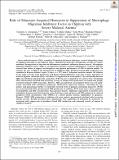| dc.contributor.author | Gordon A Awandare, Yamo Ouma, Collins Ouma, Tom Were, Richard Otieno, Christopher C Keller, Gregory C Davenport, James B Hittner, John Vulule, Robert Ferrell, John M Ong'echa, Douglas J Perkins | |
| dc.date.accessioned | 2020-11-19T06:31:40Z | |
| dc.date.available | 2020-11-19T06:31:40Z | |
| dc.date.issued | 2007 | |
| dc.identifier.uri | https://repository.maseno.ac.ke/handle/123456789/2847 | |
| dc.description.abstract | Severe malarial anemia (SMA), caused by Plasmodium falciparum infections, is one of the leading causes
of childhood mortality in sub-Saharan Africa. Although the molecular determinants of SMA are largely
undefined, dysregulation in host-derived inflammatory mediators influences disease severity. Macrophage
migration inhibitory factor (MIF) is an important regulator of innate inflammatory responses that has
recently been shown to suppress erythropoiesis and promote pathogenesis of SMA in murine models. To
examine the role of MIF in the development of childhood SMA, peripheral blood MIF production was
examined in Kenyan children (aged <3 years, n 357) with P. falciparum malarial anemia. All children
in the study were free from bacteremia and human immunodeficiency virus type 1. Since deposition of
malarial pigment (hemozoin [Hz]) contributes to suppression of erythropoiesis, the relationship between
MIF concentrations and monocytic acquisition of Hz was also examined in vivo and in vitro. Circulating
MIF concentrations declined with increasing severity of anemia and significantly correlated with peripheral blood leukocyte MIF transcripts. However, MIF concentrations in peripheral blood were not significantly associated with reticulocyte production. Multivariate regression analyses, controlling for age,
gender, and parasitemia, further revealed that elevated levels of pigment-containing monocytes (PCM)
was associated with SMA and decreased MIF production. In addition, PCM levels were a better predictor
of hemoglobin and MIF concentrations than parasite density. Additional experiments in malaria-naive
individuals demonstrated that hemozoin caused both increased and decreased MIF production in cultured
peripheral blood mononuclear cells (PBMC) in a donor-specific manner, independent of apoptosis.
However, PBMC MIF production in children with acute malaria progressively declined with increasing
anemia severity. Results presented here demonstrate that acquisition of hemozoin by monocytes is
associated with suppression of peripheral blood MIF production and enhanced severity of anemia in
childhood malaria | en_US |
| dc.publisher | American Society for Microbiology Journals | en_US |
| dc.title | Role of monocyte-acquired hemozoin in suppression of macrophage migration inhibitory factor in children with severe malarial anemia | en_US |
| dc.type | Article | en_US |

